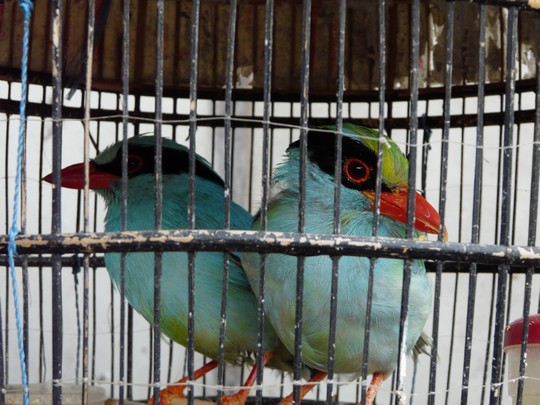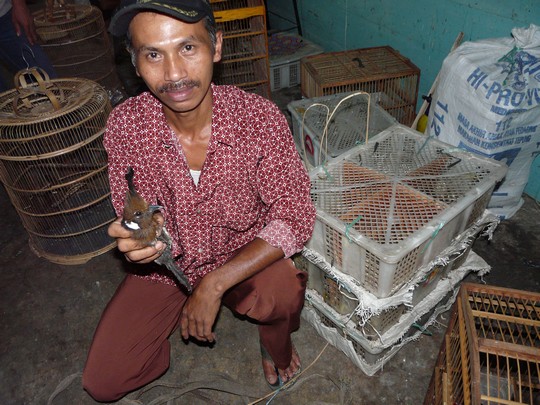Livelihoods trump conservation in a Sumatran village
Anton Lucas
Earlier this year, before I embarked on a month’s fieldwork in an upland village in the interior of Bengkulu province, in southern Sumatra, the following item caught my attention in the English daily The Jakarta Post of 18 March 2011:
‘A survey conducted by ProFauna Indonesia in 70 bird markets in 2009 discovered 183 protected species were still being traded illegally. Of the 70 bird markets or locations inspected in 58 towns, 14 traded parrots and cockatoos, 21 traded primates, 11 mammals and 13 birds of prey. Eleven markets sold protected species of songbirds.’
So it did not come altogether as a shock for me when, during my subsequent fieldwork, which involved a survey of village households in Lebong district, I discovered two families whose livelihoods depend on catching songbirds in a still heavily forested area of the 1.4 million hectare Kerinci Seblat national park, three and a half hours walk from the village. Pak Sudri is one of two landless villagers going on six or seven day trips two or three times a month to bring back about 40 songbirds (the species are mostly poksai or palak putih, palak coklat, cucak hijau and ceking hijau) each trip.
‘It takes four days to make the trip worthwhile’
Pak Sudri and his fellow villager usually go together into the national park because ‘It’s too expensive to go on your own. You have to carry food for seven days, boxes to carry the birds back in and plastic tents. It takes a day to walk into the park and set up camp, then you have to walk another hour into the forest. You paint the sticky sap (pulut) onto the leaves of fruiting trees the birds come to feed on, or set the sticks with rat catcher glue. You need four days to catch enough birds to make the trip worthwhile,’ Sudri told me.
On their return to their village, Sudri takes his share of the captured birds to sell to a bird trader in the district capital of Curup, three hours away by public transport. To save the cost of birdseed they sell them as quickly as possible. Some birds are still young, fledglings which have recently left the nest and can’t yet sing. Older birds which can sing fetch much more, but Sudri can’t afford to keep birds for long enough to sell them for better prices, also because of the risk they might die before he can sell them.
‘Male cucak hijau are loud whistlers. The bird trader in Curup will lend you a male bird whose whistle will attract other birds. You put the cage on top of a tree and smear a sticky sap mixture onto the leaves and branches of fruit trees where the cucak hijau come to feed. Their feet get stuck in the sap. But you can only catch one or two of these birds in a day.’
In contrast, poksai come in flocks of eight to ten birds and are also caught with sticky sap painted on the leaves near the fruits they feed on. But Pak Sudri prefers to use rat catcher glue painted onto thin bamboo sticks which are tied to the trees or planted in the ground around them. The birds’ feet get stuck to the sticks. ‘I prefer this method,’ he says. ‘It says on the tin that the glue is not poisonous, the birds can clean it off themselves. If we use the sticky tree sap we have to clean it off their feet and feathers using kerosene.’ (Later the bird trader told me the opposite; it was the rat glue that had to be cleaned off the birds with kerosene).
‘No-one knows where the park boundaries are’
Does Sudri know that he is catching these birds inside a national park? At first, he was a bit defensive about this. ‘I don’t know whether we are catching the birds in the park or not,’ he says, ‘because there are no boundary markers. No-one in the village knows where the park boundaries are.’ This was verified by other informants: only one person in the village survey of 40 households remembered ever seeing a metal marker plate on a tree, and that was many years ago.
 |
|
The sticks used that are coated with rat glue and used to catch birds / Anton Lucas |
But Sudri claims his bird catching is not reducing the bird population overall, although he can see the impact of others: ‘We see traces of other bird hunters, and in these areas the bird populations have declined.’ However, he says that he and his fellow catcher from the village don’t take enough birds to cause a decline in numbers. ‘Poksai and ceking hijau come in flocks up to 10 or 11 birds, and we take three to five young birds at the most ...also we can’t carry supplies for more than a week-long trip’.
Because of the time it takes to walk into forested areas of the national park, once they arrive there are only four days left for catching birds. ‘We limit the number we catch on each trip to 40 birds. If we carry more than 40 birds, it’s too hot and crowded in the boxes for them to survive. So if we get 40 birds in two days we stop before the four days is up’, said Sudri, showing me four large white plastic boxes, provided, he said, by a bird trader (the trader later denied this). Sudri says the limit to how many they can carry also prevents them taking too many.
Later he is frank about why he catches birds for a living. ‘I work as a casual labourer, there are only five landholders who will give me work in our village. For ten months of the year I’m lucky to get ten days work a month. They pay me Rp.30,000 ($US3.50) a day, that’s Rp.300,000 a month. In the season of scarcity (musim paceklik – the dry season) that’s the most work I can get. During the coffee harvesting season I can get 20 days work a month’.
So the economics of catching birds are irresistible for Pak Sudri and his fellow catcher. If they come back with 40 birds of different varieties, but mostly poksai putih, they can make a total of between Rp.400,000 and Rp.500,000 per trip. If they go on three trips a month in the dry season, they can get Rp. 1,400,000 a month. After deducting expenses (food, rat catcher glue, birdseed, transporting the birds to Curup), they are left with Rp 375,000 each, just enough to feed a large village family for a month. Sudri has five children with a sixth on the way.
‘I wouldn’t be catching birds if there was enough work around in the village,’ he says. ‘If I found out that these birds are protected I wouldn’t hunt them anymore. One of the bird traders in Curup had a poster in his shop of protected species including birds. I didn’t see the three species I catch on the chart. And the book of protected species we studied in the sixth grade in elementary school didn’t have them in it either. Also when I go to the bird trader’s shop to sell my birds I see police officers, military people, and government officials including forestry officials who are all buying birds. So I thought, ‘This is not a problem, I am not breaking the law catching birds. If I could find work some other way I would.’ (When I visited the bird trader’s shop in Curup some days later, a policeman in plain clothes bought an expensive cililin song bird, one of a new batch just arrived).
An industry with poor prospects
Sudri is gloomy about the future: ‘We can’t catch birds in the future, if we go on catching birds they will eventually be extinct,’ he says. ‘As I get older I won’t have the strength to catch birds anymore. It’s physically very demanding, also it’s dangerous work, there are snakes and tigers to deal with.’ Finally, he said, ‘If the national park authorities put up markers which clearly show the boundaries of the national park, then so be it, we just have to accept it. We can’t oppose the government’.
Some days later, on the return journey to Bengkulu, I found the bird trader’s shop in the district capital of Curup. While I was there two bird catchers arrived from Jambi with 13 sought after cililin songbirds to sell. When they opened the boxes one had died. The trader (Pak Sapto, not his real name) paid Rp. 275,000 per bird, so the two catchers walked out of the shop a total of Rp.3,300,000 better off.
 |
|
Ceking hijau songbirds in the trader’s store / Anton Lucas |
‘Look at their mobile phones,’ said Pak Sapto as they were leaving, ‘more than a million rupiah each. Of course they will go on catching birds as long as they can. It’s an easy living for people who are too lazy to find work elsewhere.’ But Pak Sapto had avoided discussing the profit he makes selling songbirds; he was frank that it was a better livelihood than his most recent occupations, as a building contractor and, before that, a vegetable seller. On the bird catchers’ options, he reported: ‘If they go on three five to seven day trips a month, ‘They can make Rp.3,000,000 per month from catching birds or Rp. 100,000 per day. They do it for three reasons: for a hobby, or because they are poor, or because they are too lazy to find work elsewhere.’
I asked the bird trader whether he bought protected birds. Pak Sapto was quite defensive. Initially, he questioned whether the birds he was buying were caught in the national park since the Kerinci Sebelat Park boundaries weren’t clearly marked; and anyway, if they were caught in the park it didn’t mean they were protected. ‘I know of only one species that is protected here, that is the cecak rowo, which sells for around 4 million rupiah. Most of the endangered species like cockatoos are in Java, not here in Bengkulu. You need permission to own these birds. If you can’t prove how long you’ve owned the bird, then it’s probably only recently been caught. I wouldn’t risk buying it.’
‘We can’t feed our families without catching birds’
Both bird catchers in the village say they can’t feed their families without hunting birds. Sudri says he wished he could have another livelihood but he has to think of his children. Keeping birds started as a hobby, he says, but the expense of catching them (even with help from the trader) is making it harder to make a living. Sudri compares himself with fishers because ‘the risks of going out to sea and going into the forest are the same.’
With the two catchers I met catching up to 120 birds per month, and assuming the four they knew in other villages catch the same number, that’s roughly 500 birds a month being caught and sold in just one small part of the Kerinci Seblat national park. You can see and hear these birds singing their beautiful songs in captivity anytime on the internet. Perhaps YouTube will eventually be their final refuge?
Anton Lucas (anton.lucas@flinders.edu.au) is recently retired from Flinders University where he taught and researched Indonesian politics, agrarian and environmental issues.











